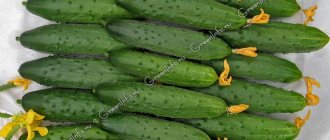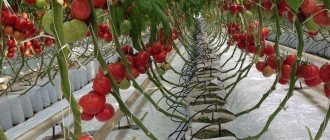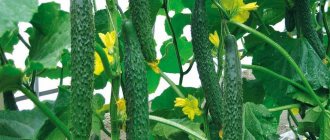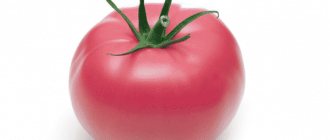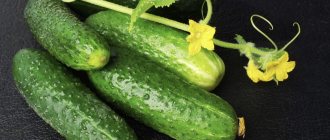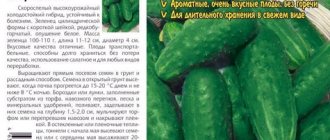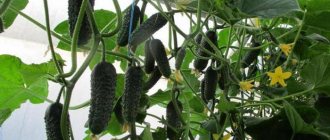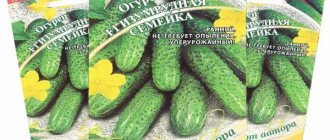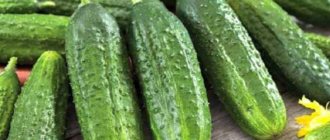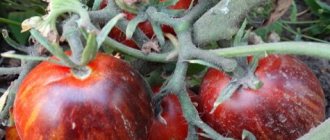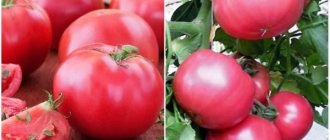Vegetable growing » Cucumbers
0
1436
Article rating
Kira Stoletova
The White Angel cucumber variety is perfect for lovers of delicious juicy vegetables. The fruits of this variety differ in color: they are light green, almost white. It is the appearance that attracts gardeners.
Characteristics of the cucumber variety White Angel
Caring for White Angel cucumbers is no different from the traditional one. Timely watering, maintaining temperature conditions, regular fertilizing are the main procedures. Another advantage of the variety is high yield.
Description and characteristics of the variety
White Angel F1 is a mid-season hybrid variety. The first harvest is harvested 50-55 days after germination.
Shoots are characterized by indeterminate growth, the main shoot grows without restrictions. Many side stems grow from it. Flowering is of a mixed type, but with a predominance of female inflorescences. The leaves are medium-sized, rich green in color, with an irregularly shaped edge. From 1 node there are 2 ovaries.
Cultivation is carried out in various regions and conditions:
- in heated film and temporary greenhouses;
- in greenhouses and tunnels.
Planting in open ground is possible.
An important condition is timely removal of fruits (once every 2-3 days). If you miss the deadline, then in the second wave the cucumbers lose their marketability and exquisite taste. The fruits become barrel-like, the skin becomes very rough, and the seed nest grows.
Authorship belongs to S.F. Gavrish and a group of breeders - Shevelev, Portyankin, Shamshina.
Description of fruits:
- length no more than 10 cm;
- diameter 2-3 cm;
- light olive skin;
- pubescence is barely noticeable;
- tubercles are weakly expressed;
- spines white;
- average weight up to 90-100 g;
- The pulp is juicy, sweetish, and has a loose consistency.
The fruits are used for fresh consumption - in salads, slices, assorted dishes, light summer dishes, cucumber juices. When preserved, these vegetables have an interesting taste, reminiscent of squash.
Harvesting and application
Harvesting begins in July-early August .
It is recommended to collect fruits without waiting for them to outgrow - when they reach a length of 5–7 centimeters. A 10-centimeter cucumber is already considered overgrown. Ripe fruits are harvested daily or every other day , in the evening or morning. Correct harvesting is not to pick the cucumber from the bush, but to carefully cut it with pruning shears, leaving the stalk on the stem.
The collected cucumbers are placed in a cool room, protected from direct sunlight, and covered with burlap or other light natural fabric.
Store the harvested crop fresh for two weeks if you use one of these methods:
- Wrap the cucumbers in plastic wrap and leave in a cool place.
- Place the fruits, legs down, in a bowl of cold water (change the water periodically).
- Wash the cucumbers, dry them and coat each one with egg white.
Fresh White Angel fruits look original in colorful salads . In color and taste they go well with tomatoes, sweet peppers, dark olives and green cucumbers.
Housewives often use unusual cucumbers for pickles and pickling .
Reference. The recipe for pickling White Angel cucumbers is standard - the same as for green cucumbers: for a three-liter jar: 100 g of salt, 100 g of sugar, 50 g of vinegar. The versatility of the recipe allows you to create beautiful and original “compositions in jars” from cucumbers of different colors.
Since the taste of the fruits does not differ from other cucumbers, they are used in any other preparations.
How to grow these unusual cucumbers?
First you need to prepare the soil. White cucumbers are quite demanding on the soil, so it must meet the following parameters:
Many summer residents claim that white cucumbers are tastier than green ones.
- have good fertility;
- absorb water and pass it through just as well so that there is no stagnation;
- the soil should have a slightly acidic reaction, closer to neutral (pH 6.5-7).
The most suitable soil for cucumbers is considered to be a mixture of humus and turf soil. It is also recommended to add sawdust from coniferous wood. Thanks to this technique, the soil becomes loose and drains water well. Potassium sulfate, superphosphate and ammonium nitrate are used as mineral additives. It is advisable to add quicklime and wood ash to the soil, which will significantly reduce the risk of fungus developing in the soil. 25-day-old seedlings are planted in prepared and disinfected soil.
The hole is completely filled with water, a pot with a young cucumber is immersed there and covered with soil up to the level of the root collar. It is recommended to cover the top with mulch, which will prevent moisture from evaporating and prevent the formation of an earthen crust.
A few days after planting, young plants are tied to trellises and then regularly twisted around a rope through each internode. Since the main representatives of white varieties are long-stemmed and can reach 2 m in height, their growth is limited by pinching.
Advantages and disadvantages
The main difference between White Angel cucumbers and other varieties is the originality of color. White cucumbers look original both on the table and in glass jars. Also, the absence of a coloring pigment in the fruit is a positive factor for people with allergies.
- In addition, the White Angel variety has the following advantages:
- excellent taste;
- high productivity;
- good transport tolerance;
- resistance to changes in climate and weather conditions.
- The disadvantages of the variety are:
- low resistance to diseases;
- fruits longer than 6 cm become coarse, their flesh becomes thin;
- during the second wave of harvest, watery, thick-skinned pear-shaped fruits may appear.
Advantages and disadvantages
The white angel has both disadvantages and advantages.
Advantages of a hybrid:
- excellent taste;
- original type of fruit;
- unpretentiousness to growing conditions;
- possibility of long-term storage.
Minuses:
- instability to diseases and pests;
- rapid outgrowth of fruits;
- a decrease in the quality of fruits during the second wave of harvest (lumpy, thick-skinned, watery pulp, loss of the correct cylindrical shape).
Popular varieties
There are not yet as many white varieties of cucumbers as there are green ones, but among them you can choose ones worthy of cultivation. They differ in the following characteristics:
- suitable for open ground and greenhouse structures;
- the fruits have a spiked or smooth surface;
- long or the size of gherkins;
- used for summer salads and winter preparations;
- There are both parthenocarpic and bee-pollinated species.
White varieties of cucumbers are not yet very popular in Russia, so they are not used for sale on the market on a large scale.
Snow White
High-yielding, early-ripening variety. Easily tolerates temperature fluctuations. The crop is grown in open ground and greenhouses.
The peel is thin, the vegetables taste pleasant, slightly sweet. The color of the fruit is snow-white. The flesh is tender and the texture is soft. The seeds are small; there are not many of them in cucumbers. The variety is very popular among farmers.
Snow White cucumbers are mainly grown for industrial purposes, for sale. The fruits are suitable for canning and fresh consumption.
Italian white
Vegetables have a smooth surface with a small number of tubercles. The length of the fruit is 20 cm. The pulp is soft, juicy and aromatic.
The plant is tall and therefore requires obligatory gartering to a support. Some people grow the crop horizontally. An unpretentious variety with high disease resistance.
White angel f1
Early ripening hybrid.
Vegetables reach technical maturity in 50-55 days. Mixed flowers. These cucumbers are cultivated both in open and closed ground. The weight of one fruit reaches 60-70 g, length - 7-9 cm. There are small white thorns on the surface.
Vegetables are not bitter, but when they are overgrown, they lose their taste. Immunity to diseases is weak. White angel is used for preparing fresh salads and canning. Productivity reaches 12-15 kg per 1 sq. m or 4 kg per plant.
White delicacy
The mid-season variety was bred by Chinese breeders. Technical maturity of vegetables occurs 45-50 days after emergence. The crop is grown in open ground and greenhouses.
Cucumbers have a conical shape. The length of the tuberculate fruit reaches 12-15 cm. The peel is tender and soft, and has no bitterness. Up to 4 kg of crop is harvested from one bush. Cucumbers can be canned, pickled and eaten fresh. The culture has strong immunity to diseases.
Cucumber "White delicacy"
Snow Leopard
High-yielding variety. The maximum length of vegetables reaches 25 cm. The bush grows up to 3 m in height. As the crop grows, it is tied up or sent to special nets installed nearby. Vegetables can be picked when they reach 6-8 cm. Basically, cucumbers of this variety are pickled or pickled.
Martini f1
Cucumbers have a yellowish tint with a green tint. The fruits are small, 8-14 cm long. The shape of the vegetables is oval-elongated. There is no bitterness in the pulp, even if the cucumbers are overripe. Productivity is high, from 1 sq. m harvest from 10 to 14 kg of crop.
Cucumber “Martini f1”
Bride
An early ripening variety, pollinated by insects. Vegetables ripen in about 40 days. The plant is tall. For 1 sq. m, no more than four bushes are grown and up to 20 kg of vegetables are collected. The taste of the fruit is pleasant, slightly sweet. The flesh is tender. The variety needs frequent watering and responds well to organic fertilizing.
Cucumber "Bride"
Bidigo-Lungo
The hybrid was bred specifically for greenhouse cultivation. Thanks to this, the fruits are harvested before October-November. The variety is early ripening and high-yielding, bears fruit for a long time. The fruits ripen within 50 days after planting in the greenhouse. They are mainly consumed fresh.
White crunch f1
The hybrid is mainly grown in greenhouse conditions, but it is also suitable for open ground. It takes about 45 days from sowing to harvesting the fruit. Productivity is high. The fruits are thornless, the skin is smooth and white.
Cucumbers are tasty, tender and aromatic. They reach 180 g in length, but it is better to collect fruits up to 10 cm. Even overripe cucumbers are not watery, but they still lose their taste.
Cucumber “White crunch f1”
White sugar f1
This mid-season hybrid was bred by Ural breeders. The fruits are 8-12 cm long and have a creamy white color. The harvest is harvested 45-50 days after germination. The sparsely tuberous fruits have a delicious taste and are universal in use.
The lashes are not spreading; they do not require pinching or pinching. The crop is grown both in open and closed ground.
Description of Kustovaya cucumbers
The Kustovaya cucumber is a hybrid variety that a team of Russian breeders worked on to create. The variety was bred in 1980. According to the ripening period, Kustovaya cucumbers belong to the mid-season varieties. The first harvest is harvested 45-50 days after the formation of the first shoots.
Since Bush f1 cucumbers need pollination by insects, growing them in a greenhouse or greenhouse is quite difficult. However, gardeners suggest growing the variety under temporary shelter, which is made from film.
Characteristics of the variety:
- The bushes and vines of the plant are not tall: the plant grows up to 1.5 m, and the vines – up to 70 cm;
- The leaves of the bushes are small and colored rich green;
- Description of flowering: uniform flowering (female and male) of a rich yellow color is observed on the bushes;
- Cucumbers of the Bush f1 variety are medium-sized (12 cm);
- The peel of the fruit is thin with small tubercles and stripes, dark green;
- Description of the pulp: rich, crispy, dense, has no voids;
- Taste qualities of the variety: sweet, without bitterness.
Reviews of White Angel cucumbers
Most gardeners and farmers speak positively about the White Angel hybrid.
Julia, Voronezh : “I grew a hybrid for testing. Now I can say with confidence that White Angel are the best cucumbers I have ever tried and grown. I harvest every day. They don't taste bitter. They look exclusive, but in color they are rather light green. Although in comparison with other cucumbers, they really look white. Among the shortcomings, I can only note the thorniness of the fruits; it is difficult to pick them with bare hands.”
Larisa, Orel : “The white angel is only suitable for exoticism - to surprise neighbors and friends. Half of the seeds did not germinate, there were few ovaries - as a result, the yield was lower than expected. I didn’t notice any differences from a regular cucumber, except for the color - the taste and smell are the same.”
Ivan, Tula : “I’ve been farming for several years now, I tried the White Angel hybrid. Disappointed with the second wave of the harvest: the fruits quickly became deformed and could not be sold. Therefore, I will no longer risk growing white cucumbers - farmers have other priorities, and the exclusivity of the fruit is not on their list.”
Resistance to diseases and pests
This variety is susceptible to attacks by various diseases. You can often observe the formation of white mold. It develops quickly in a greenhouse. Against the disease it is advised:
- observe the temperature regime;
- periodically feed the plants;
- tie as it grows.
In case of infection, you should promptly remove the diseased plant, along with the root.
You may be interested in:
Fighting spider mites in a greenhouse on cucumbers If you are interested in the question of how to get rid of spider mites on cucumbers in a greenhouse, you should familiarize yourself with folk...Read more...
Cucumbers are prone to infection with mosaic, brown and olive spot, powdery mildew, cladosporiosis, sclerotinia and other diseases.
Prevention includes activities:
- plant not densely;
- thorough weeding;
- watering with warm water only;
- regular fertilizing containing nitrogen, potassium, phosphorus.
The variety is not resistant to aphids and mites. Onions and garlic are used against them, dill is scattered between the ridges.
Important!
Before planting plants in the beds, you need to disinfect them with a 0.05% solution of potassium permanganate and dig them thoroughly.
Description of cucumbers
White angel is suitable for growing in open ground and greenhouse conditions throughout the country. It is unpretentious, but maintaining the parameters recommended by breeders (temperature, humidity, soil composition) is necessary.
On average, 44–50 days pass from sowing to the first fruits. The hybrid is parthenocarpic, the ovaries are arranged in bunches. It branches strongly and forms powerful lashes.
Distinctive features
The non-standard color is a distinctive feature of the hybrid; otherwise, it is an ordinary cucumber, suitable for fresh salads and pickles.
In addition to the unusual white color, the fruits of this hybrid are characterized by:
- thin peel;
- small, non-prickly tubercles;
- juiciness and aroma;
- lack of pubescence on the fruit;
- cylindrical shape.
Despite the thin skin, the White Angel cucumber withstands transportation and storage very well.
Composition and properties
White angel, like all cucumbers, is 95% water. Contains fiber and vitamins A, B1, B2, C, PP. It is useful for its high content of minerals, which makes it popular for dietary nutrition. The composition contains potassium, magnesium, zinc, copper, manganese, iron, chlorine, iodine, chromium, phosphorus, sodium, folic acid.
Regular consumption of vegetables helps remove waste and toxins from the body, gently cleanse the intestines, and activate metabolic processes.
White angel is a constant helper for all those losing weight: it contains only 15 kcal per 100 g.
Green cucumbers rarely cause allergic reactions, and white cucumbers are absolutely safe in this sense. The absence of a coloring pigment reduces the risk of allergies to zero.
Features of cultivation
Traditionally, white varieties and hybrids of cucumbers are cultivated both in greenhouses and in open ground.
Planting is carried out with seeds or seedlings, the age of which reaches 25 days. The distance between planting holes is approximately 15-20 cm. After thinning, 2-4 plants are left per linear meter, depending on the variety. The soil for planting cucumbers must be fertile, loose, slightly acidic or neutral - pH = 6.5-7.
Additional addition of wood ash or lime to the soil will prevent the development of fungal diseases. To maintain soil moisture and looseness for a longer period, plantings are mulched.
Grown plants are tied to a stretched mesh or vertical trellises. This provides them with optimal growing conditions - sunlight and fresh air, and also keeps the vegetables clean.
Ovaries are formed on both the main and side shoots, so they do not require formation. But if desired, the growth point of the main stem is pinched, thereby stimulating the formation of side shoots and increasing the yield.
Otherwise, white cucumbers need standard agricultural practices:
- loosening the soil;
- weed removal;
- watering;
- fertilizing with mineral fertilizers - for example, potassium sulfate, superphosphate or ammonium nitrate - 3-5 times during the entire growing season.
Organic fertilizers, fermented infusions of mullein, chicken droppings or nettles are also used as fertilizers.
Unlike green cucumbers, white cucumbers are less demanding on the frequency of watering. They are moistened abundantly in the morning or evening with warm, settled water every 3-4 days. Watering in the middle of the day provokes leaf burns.
White cucumbers love high humidity. To do this, dig a container into the ground next to the plants - for example, a barrel - and fill it with water. During evaporation, air humidity will increase, creating an optimal regime for the crop.
Cucumbers are cut when they reach a length of 10-15 cm - about twice a week. Most varieties and hybrids do not lose their taste when outgrown. In greenhouses, white varieties bear fruit until frost.
Typical diseases and pests
The main feature of white cucumbers is their resistance to diseases and pests. They are practically not affected by aphids, peronospora and other characteristic diseases.
According to reviews from experienced gardeners, white cucumbers are not treated with anything when growing, but they follow the rules for preventing diseases and pests:
- do not plant cucumbers close to each other;
- periodically remove weeds from the site;
- do not moisten the plantings with cold water;
- Fertilize regularly;
- After planting, young plants are treated with Bordeaux mixture.
If you follow these measures, you will not have to fight diseases.
Blond
The Blonde cucumber is not completely white. Only his “nose” remains light. Closer to the stalk, the shade gradually turns into a light green, then into a dark green shade. However, breeders classify it as a member of the white cucumber group. The vegetables taste great.
They are suitable for making salads. The crop is grown in open ground and under film covers, but one must always take into account that the Blondin variety is not a parthenocarpic crop and requires bee pollination:
- early variety. Vegetables ripen on day 45;
- the bush is spreading, indeterminate, requires tying and shaping;
- Both female and male inflorescences are formed on the bush. One flower grows in the axils of the leaves. For the formation of ovaries, pollination is necessary;
- the cucumber is long, up to 20 cm. Average weight is 125 g. The surface is tuberous with black spines and white edges;
- marketable yield 11.8 kg/m2. The plant continues to bear fruit for up to 6 weeks;
- The Blondin variety has good immunity, does not suffer from powdery mildew, and is resistant to cladosporiosis.
To attract bees to the greenhouse, it is recommended to plant aromatic herbs in the beds. They attract pollinators and repel insect pests. Basil, dill, and decorative flowers such as marigolds are often planted along the perimeter of the cucumber bed. Some gardeners water with sugar, but the sweet taste attracts not only bees, but also wasps, which eat the fruits.
More on the topic: How to care for red mullet cucumbers?
Care
White Angel cucumbers do not require careful care. You should follow simple rules of agricultural technology, as well as harvest on time. Plant care activities include the following work:
- regular and moderate watering;
- weeding;
- formation of bushes, their garter;
- application of nutritional supplements;
- hilling.
Watering
The White Angel variety needs to be watered depending on weather conditions. In hot, dry weather, when the soil dries out greatly, cucumbers should be watered daily. In rainy weather, cucumber bushes should not be watered.
Moistening of plantings is carried out in the evening, after sunset, with warm water and only at the root of the plants.
Garter and bush formation
Bushes of the White Angel variety are characterized by medium climbing and unlimited growth. To prevent ripe cucumbers from falling on the ground, borage should be tied to suitable structures. They use special trellises and mesh. In greenhouses, thin twine is tied to the ceilings, along which the growth of cucumber crops is directed.
To develop side shoots and obtain the best harvest of cucumbers, it is recommended to pinch the main stem of the cucumber bush.
The leaves located at the bottom must be torn off after collecting the fruits from the lower branches. It is advisable to remove the stepsons that interfere with the normal fruiting of the White Angel vegetable crop.
Top dressing
Cucumber plants of the White Angel f1 variety require periodic feeding with nutrients. During the season it is necessary to make 3-4 additives using organic and mineral fertilizers. It is recommended to alternate organic matter and minerals. Infusions of chicken manure (1:25), mullein (1:10), and phosphorus-potassium fertilizers are suitable.
Fertilizing consisting of manure and nitroammophoska is quite effective for cucumbers. Description of the fertilizer mixture:
- 500 ml of manure infusion;
- 1 tbsp. spoon of nitroammophoska;
- 10 liters of warm water.
The mixture is infused for two hours and then poured under the cucumber bushes. This fertilizer is enough for 2 square meters. meters of White Angel plantings.
Hilling
Cucumber bushes require hilling. This event is carried out after watering or rain. The earth is raked under the cucumber bushes, forming a small ridge 5-7 cm high. Hilling of plants of the White Angel species is carried out in order to protect the plantings from pests, as well as for more free penetration of oxygen to the root system.

